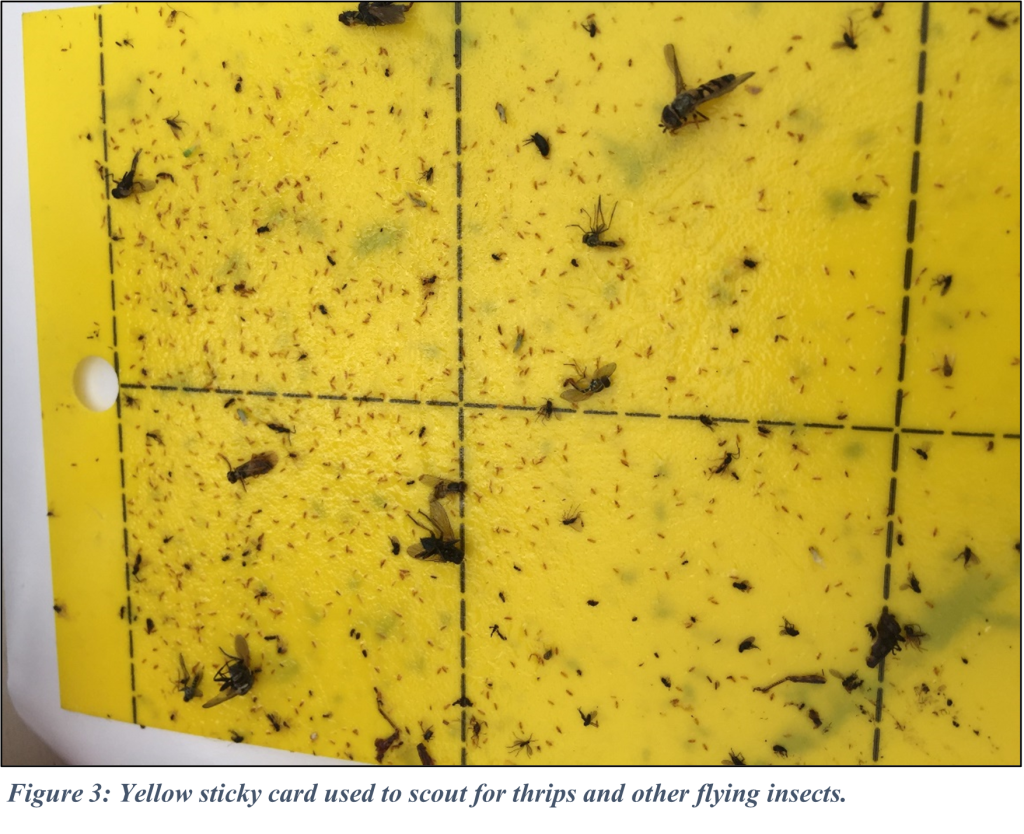An invasive thrips species, Thrips parvispinus, commonly known as the Pepper Thrips, is emerging as a destructive new pest in North America. Native to southeast Asia, it has spread globally through the horticultural industry. First intercepted in the U.S. in Hawaii, it is now widespread within Florida and threatens to move into the rest of the country through shipments of ornamental and vegetable plants. This article will outline valuable information available on the known host range of plant material Pepper Thrips can attack, how they are to be identified, and what chemical strategies have been evaluated for combatting this newly developing pest.
Scouting & Identification
Feeding damage to leaves, buds and flowers causes abnormal growth, including dwarfed growing tips that can mimic broad mite damage in some cases. Because the T. parvispinus is new to North America, the list of host plant species is changing rapidly, but some key ornamental and vegetable crops have been documented as shown in the table below.
| Tropicals | Fruits and Vegetables | Spring Bedding |
|---|---|---|
| Gardenia | Pepper | Gerbera Daisy |
| Dipladenia1 | Bean | Chrysanthemum |
| Hibiscus | Cucumber | Marigold |
| Mandevilla | Squash | Dahlia |
| Anthurium | Zucchini | Sunflower |
| Schefflera | Strawberry | Flowering Vinca |
T. Parvispinus are the smallest dark thrips (smaller than Chilli Thrips) that growers are likely to encounter during production. Females and males differ in size and color. Females are approximately 1 mm long (i.e., a little over 1/32 in), and males are almost half the size at 0.6 mm long. Males are yellow, while the females have a brown head, black abdomen, and a distinctive yellow thorax (Figure 1). The wings are dark, with light a colored base where they overlap the thorax. The third antennal segment and the base of the fourth and fifth segments are light colored, giving them a broken or “striped” pattern. All leg segments are light colored.

T. parvispinus prefers tender young growth but will also feed on flowers and fruit (Figure 2). They are difficult to find on foliage due to their size and ability to hide in the deformed growth but are easily spotted on the flowers of tropical ornamentals, where they can be found inside the

flower or hiding between overlapping petals. Scouting tools should include a good hand lens and a white sheet of paper on a clipboard to conduct a beat test. As with other thrips species, yellow or blue sticky cards are also effective at detecting their presence (Figure 3).

Crop Protection Strategies
Initial crop protection trials against Pepper Thrips have provided growers with various approaches that have some overlap with control strategies of Western Flower Thrips. Using the limited data available and our understanding of the thrips life cycle, GGSPro recommends using foliar sprays twice in a row, 5-7 days apart before rotating to a new mode of action (MOA). This method improves control in many cases and treats each generation of thrips with a specific mode of action, ultimately slowing the carryover of genetic traits for resistance. Pesticides to use in this strategy would include Conserve or XXpire (both MOA 5), Avid + Azatin O (or another azadirachtin product such as Aza-Direct or AzaGuard EC), Hachi-Hachi, and Pylon. Flonicamid containing products such as Aria and Pradia have also been shown to be effective foliar spray options. Although we are very early on in our understanding of this new pest, there are several other pesticides worth trialing for protection and control of Pepper Thrips. These include Mainspring (spray and drench), Kontos (drench), Pedestal, and Overture. From a biological control agent (BCA) approach, additional research is needed to determine appropriate rates and release frequency for the predatory mites Amblyseius cucumeris and swirskii or other predators such as Orius insidiosus and Atheta coriaria.
Photos from the University of Florida sourced from: https://mrec.ifas.ufl.edu/lsolab/thrips/thrips-parvispinus/
Note, not all products are registered in all states. Some pesticides are restricted use in some states or regions and not others. It is the responsibility of the applicator to read and follow all label directions including potential phytotoxicity/plant tolerance statements, remembering that labels may change. Rates, application methods, and edible status are detailed in our GGSPro Insecticide & Fungicide Guides. Griffin also offers the 5th Edition GGSPro Technical Reference Guide in both English and now Spanish versions. This valuable resource outlines a wide range of pest control options along with information on pollinator safety, BCA’s, scouting, weed management, plant lighting, nutrition, water quality and more!
| Products | Item # |
|---|---|
| Aria | 70-3399 |
| Avid | 70-1180 |
| Aza-Direct | 70-1222 |
| AzaGuard EC | 70-1224 |
| Azatin O | 70-12301 |
| Conserve | 70-1365 |
| Hachi-Hachi | 70-1795 |
| Kontos | 70-19601 |
| Mainspring | 70-2331 |
| Overture | 70-2590 |
| Pedestal | 70-29501 |
| Pradia | 70-2630 |
| Pylon | 70-2675 |
| XXpire | 70-9700 |
| Yellow Sticky Cards (50 Count) | 74-36705 |
